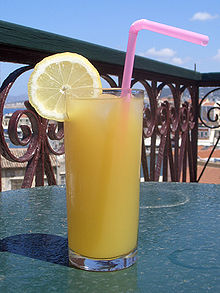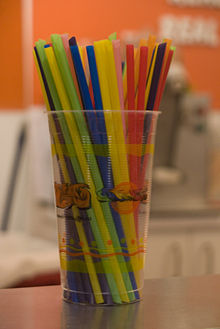- Drinking straw
-
A drinking straw is a short tube intended for transferring a beverage from its container to the mouth of the drinker by use of suction. The earliest drinking straws were hollow stems of grass, literally made of straw.[citation needed] A thin tube of plastic (such as polypropylene and polystyrene) or other material, straight or with an accordion-like living hinge, it is employed by being held with one end in the mouth and another end in the drink. Muscular action reduces air pressure in the mouth, whereupon atmospheric pressure forces the drink up the straw. The first straws were made by the Sumerians, and used for drinking beer (as to avoid the solid byproducts of fermentation). Argentines and their neighbors use a similar metallic device called bombilla that acts as both a straw and sieve for drinking mate tea. The modern drinking straw was patented in 1888 by Marvin C. Stone.[1]
Early paper straws had a narrow bore similar to that of the grass stems then in common use. It was common to use two of them, to reduce the effort needed to take each sip. Modern plastic straws are made with a larger bore, and only one is needed for ease of drinking.
One particular advantage of using a straw when drinking is the reduction of tooth decay. Many soft drinks have acidic properties, and using a straw reduces the liquid contact with the teeth, reducing tooth decay and the risk of cavities.[2][3]
Drinking straws are a form of plastic consumption when made, and become a landfill item when discarded. Made from polypropylene, they are strong and can be reused rather than recycled into other products. Waste straws in Uganda are collected from beer and soft drink depots, cleaned, and woven into mats for picnics and prayers or joined to form bags.[4]
Contents
Types of drinking straws
- A basic drinking straw is straight for the full length.
- A bendable straw or "bendy straw" (known in the industry as an "articulated straw") has a concertina-type hinge near the top for convenience. This variation was invented by Joseph Friedman in 1937.[5]
- A "crazy" straw is hard, transparent or translucent plastic and has a number of twists and turns at the top. When liquid is sucked through the straw, it quickly flows through the winding path, creating an interesting spectacle.
- A spoon straw features a cut-away shape at one end that functions as a miniature spoon. It is intended for slush drinks.
- Candy straws, such as licorice straws (or lico-straws), are made from some type of chewy candy.
- A miniature straw is often attached to a drink box.
- A wide straw is used for sipping bubble tea. The larger diameter is necessary to accommodate the drink's characteristic tapioca balls. Also for stirring.
- "Sanitary" straws are individually wrapped to avoid contamination. Straws were originally marketed as a means for people to reduce the risk of contracting an illness from improperly washed containers, glasses, or cups.
- The Sipahh is a drinking straw that contains flavoured tapioca beads that dissolve as milk passes over them, adding colour and flavour.
- A recent addition to the straw family is the cereal straw, such as the ones made by Kellogg's.
- Polypropylene is becoming favored over polystyrene for manufacturing plastic drinking straws as polystyrene is brittle and tends to crack easily. Polystyrene is also denser than water, causing straws to sink when placed into beverages. Polypropylene straws, by contrast, are much more durable and do not sink.
- Special "color-changer" straws given with meals at Friendly's change color as cold liquid passes through them.
- Extendo-straws come in small plastic wrappings like miniature straws, but can extend to reach the bottom of the carton.
Nicholson Baker's 1988 novel The Mezzanine includes a detailed discussion of various types of drinking straw experienced by the narrator and their relative merits.
Alternatives to plastic straws
 Drinking straws made of PLA-blend bio-flex, a bioplastic
Drinking straws made of PLA-blend bio-flex, a bioplastic
Plastic straws aren't recyclable and end up in landfills or the ocean. There are, however, alternatives to disposable plastic straws:
- Paper straws
- Bamboo straws
- Bioplastic straws
- Glass straws
- Stainless steel straws
Notes
- ^ US 375962, Stone, Marvin, "Artificial straw", issued 1888.
- ^ Saved By A Straw? Sipping Soft Drinks And Other Beverages Reduces Risk Of Decay
- ^ http://www.webmd.com/news/20050617/sipping-soda-through-straw-cut-cavities
- ^ http://www.Strawbags.org
- ^ Friedman and the Flexible Straw
External links
Bartending Occupations 
Tools Bar spoon · Beer engine · Blender · Chinoise · Cocktail shaker · Cocktail strainer · Corkscrew · Ice cube · Jigger · Juicer · Lemon zester · Margarita machine · Melon ball · Muddler · Muddling spoon · Nutmeg grater · Peg · Swizzle stick · WhiskGarnishes EdibleInedibleTerminology Categories:- Cocktail garnishes
- 1888 introductions
- Eating utensils
Wikimedia Foundation. 2010.



